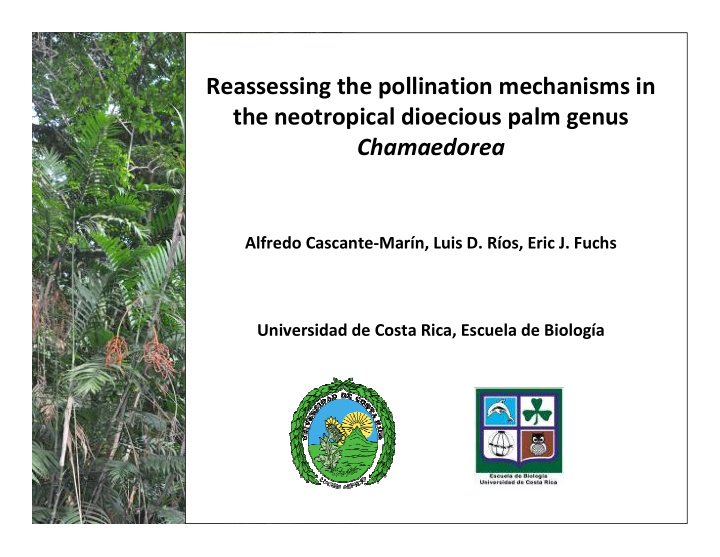



Reassessing the pollination mechanisms in the neotropical dioecious palm genus Chamaedorea Alfredo Cascante-Marín, Luis D. Ríos, Eric J. Fuchs Universidad de Costa Rica, Escuela de Biología
Pollination in Palms Among the most studied groups From wind-pollination to insect-pollination (reviewed by Henderson 1986, Badfor et al. 2011) Pollination systems in Palms (from Badfor et al. 2011)
Chamaedorea (95-100 spp.) . Neotropical & dioecious . Highly ornamental . Few pollination studies Wind Listabarth 1992 Otero-Arnaiz & Oyama 2001 (3 spp.) Berry & Gorchov 2004 Insects Morgan 2007 (4 spp.) Images from D.R. Hodel (1992). Chamaedorea palms.
Great variation in floral morphology within Chamaedorea Inflorescence level Flower level Pendant-erect Scented or not Few-many Bright-dull color rachillae Powdery pollen Short-long peduncle Exposed-inserted stigma and anthers Images from D.R. Hodel (1992). Chamaedorea palms.
Pollination systems in Chamaedora palms Our assumption Wind- Insect- pollination pollination Most species here ! *
Chamaedorea Chamaedorea costaricana macrospadix Cascante 2009 Tropicos (Mobot) Tropicos (Mobot) Cascante 2009 Chamaedorea Chamaedorea tepejilote pinnatifrons Cascante 2009 Tropicos (Mobot) Cascante 2009 Tropicos (Mobot)
Study sites
Pollination experiments Insect exclusion Natural pollination Apomixis (wind allowed) (wind + insects)
Fruit Set from Pollination Experiments 2011 and 2012 Natural (wind & insects) Insect-exclusion Apomixis * 2005 2011
Insect visitors to Chamaedorea inflorescences Order tepejilote costaricana macrospadix pinnatifrons Family Species E P E P E P E P Thysanoptera Thripidae Brooksithrips chamaedoreae +++ +++ +++ ++ +++ + +++ ++ Coleoptera Chrysomelidae Tetragonotes sp. - - - - - - ++ + Demotispa sp. - - - - - - ++ + Cryptophagidae - - - - - - ++ + Ptylodactylidae - - - - - - + - Staphylinidae - - - - - - + - Hymenoptera Apidae Trigona fulviventris + - ++ - + - - - Trigonisca buysonii - - - - + - - - Partamona orizabaensis - - - - - - + - Plebeia flavoscutellata + - + - + - - - - not observed, + occasionally, ++ frequent, +++ very frequent
The pollinators: thrips Staminate inflorescence Female inflorescence Thrips (Order Thysanoptera) Chamaedorea tepejilote (scale bar = 10 mm)
Pollination by deception in Chamaedorea palms Pistillate Staminate inflorescence inflorescence Brood site Inmature thrips
Corroborating Pollination by Wind Traps for air-borne pollen El Rodeo La Carpintera Pollen grains per trap El Rodeo: 86 (± 11 s.d.) La Carpintera: 16 (± 4 s.d.)
Which is the prevalent pollination mode? Wind, insects or both? . 52 species . 18 traits from inflorescence and flowers (presence/absence) . Clustering: Unweighted Pair Group Method (WPGMA) . Trait selection: Similarities Percentage Analysis (SIMPER) *
Chamaedorea groups based on floral trait similarities anemophily entomophily
Conclusions 1. Most Chamaedorea palms are functionally ambophilic. (also documented in Attalea speciosa and Cocos nucifera ) 2. Thrips represents a novel pollination system in palms (It deserves to be separated from other types) 3. Pollination systems of tropical dioecious species are more complex (eg. Thrips in Moraceae)
This project was supported by: Thanks to: D. R. Hodel (University of California) L. Mound (CSIRO, thrips identification) University for Peace (El Rodeo) Guías y Scouts de Costa Rica (La Carpintera)
Recommend
More recommend